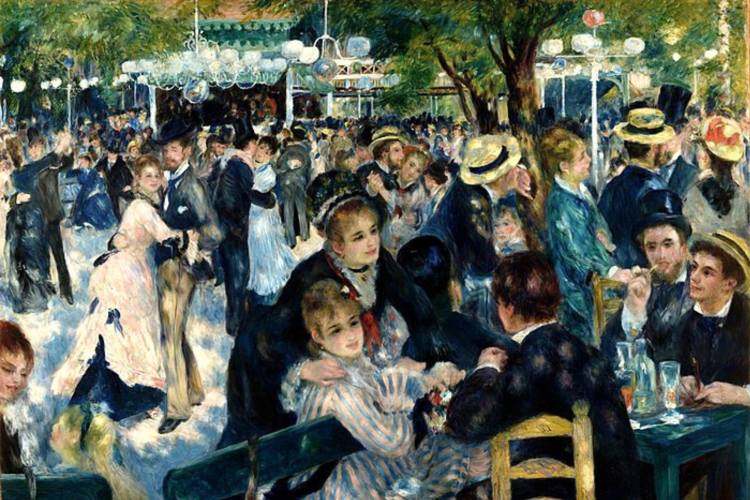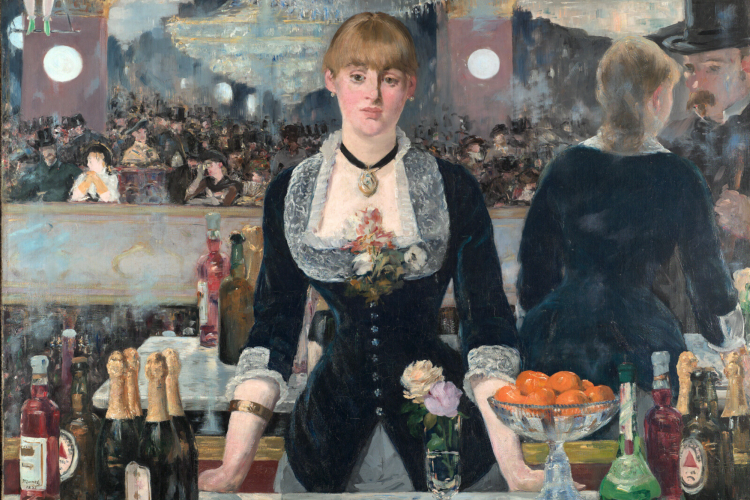13 Influential Impressionist Paintings

Impressionism is one of the most well-known art movements in the world, but what is an Impressionist painting really? Sure, you may know many of the most famous Impressionist pieces, but how much do you know about what defines the movement itself and how many Impressionist paintings can you identify?
The Impressionist art movement spanned several decades and changed the entire art landscape inspiring many more movements and paintings like the Pre-Raphaelite movement and its most popular work, the Ophelia painting. But when did Impressionism start? What painting techniques define the movement? What was the first Impressionist painting? We’re here to answer these questions and more.
Read on to delve into the world of Impressionism.
Jump to Section
What Defines an Impressionist Painting?
So what is the main idea of Impressionism, anyway? What are the five characteristics of Impressionism and what makes it so special?
Not everyone agrees on the “main” Impressionist art characteristics, but five common ones are light and color, everyday life (meaning they focused more on the mundane than the mythical), outdoor settings, spontaneity and movement along with the rejection of traditional techniques. Impressionist painting techniques were much less strict and conventional than the techniques of previous movements.
Some would also argue that the need for paintings to become more clear and beautiful from a distance is also an essential characteristic of Impressionist paintings (“Clueless” fans may remember this from the popular quote: “She’s a full-on Monet.”)
If you’re in love with Impressionist paintings and want to learn to make them yourself, check out art classes in Boston, art classes in Nashville, and art classes in San Diego. Wherever you are, there are bound to be art classes near you.

When Did Impressionism Start?
Impressionism began to take hold as an art movement in the late 1860s and early 1870s, although it didn’t get its name until a few years later. The movement lasted for several decades.
Some sources, like The Metropolitan Museum of Art, claim the movement didn’t start until the first Impressionist exhibition in 1874, but this is up for debate.
Many people wonder “Did Van Gogh paint Impressionist paintings?” The answer is: “Not quite.” Famous Van Gogh paintings were clearly inspired by Impressionism, but he is considered part of the Post-Impressionist movement instead. It also inspired the works of more modern artists like Thomas Kinkade paintings. But is a stark difference to other style like American Regionalism, as scene in Andrew Wyeth paintings.
Famous Impressionist Paintings
1. Impression, Sunrise (1872) by Claude Monet
For many people, this is the quintessential Impressionist painting, created by the quintessential Impressionist painter, Claude Monet. This painting is considered incredibly influential because it gave the Impressionist movement its name and may be the first Impressionist painting.
Art critic Louis Leroy used the term "Impressionist" to describe Monet's work and it stuck. The painting's dreamy and soft depiction of a sunrise in the harbor of Le Havre also showcased Monet's innovative use of light and color.
It has all of the classic characteristics of Impressionist art that we mentioned before and has great historical significance.

2. Bal du moulin de la Galette (1876) by Pierre-Auguste Renoir
This painting is less well-known to many Americans, but no less important to the Impressionist movement as a whole. It’s influential because of its joyful and vibrant depiction of everyday life. The painting perfectly represents a busy and bustling scene.
Renoir paintings use warm colors and energetic brushstrokes to capture the spirit of a summer evening in Paris and the piece has become an iconic representation of Impressionist painting’s focus on modern life. You can feel the life and energy within the oil painting.
3. The Cradle (1872) by Berthe Morisot
Another domestic scene, The Cradle is an intimate and gentle Impressionist painting that elegantly depicts new motherhood. It features a mother gazing lovingly at her infant in a cradle bathed in light.
Morisot did masterful work with the light on the white fabric draping over the cradle. Her unique use of color here perfectly depicts the soft brightness of an early morning or early evening putting a baby down for a nap.
4. The Dance Class (1874) by Edgar Degas
Most people can identify this classic painting by Degas depicting a class of young ballerinas. It’s considered masterful and influential due to its unique perspective and composition.
Degas uses a high vantage point and his focus on the dancers' movements and poses, rather than their faces. This creates a sense of intimacy and truly puts a spotlight on the movement of their dance.
While it’s clearer than many other Impressionist paintings, it’s still a key piece in the Impressionist movement.
5. A Bar at the Folies-Bergère (1882) by Édouard Manet
You may not know this famous painting by name, but you’ll know it when you see it. This classic piece is influential because of its enigmatic and mysterious depiction of a barmaid looking expectantly at the viewer, a mundane experience made artful.
Manet's use of a mirror behind the barmaid creates a sense of depth and raises questions about the nature of reality and representation. The painting's innovative composition has made it a landmark work of the Impressionist movement and one that’s been featured many times in pop culture.

6. Woman with a Parasol - Madame Monet and Her Son (1875) by Claude Monet
Anyone who has taken a class on oil painting for beginners can recognize this famous painting by one of the most famous painters. It stands out as a masterpiece as a result of its beautiful depiction of light and color. While the forms aren’t perfectly clear, the energy portrayed in the piece makes the scene obvious.
Monet's use of vivid colors and bold brushstrokes captured the warmth and intimacy of a family moment, like a quick snapshot. The painting's sense of spontaneity and joy has made it a beloved work.
7. The Seine at Rouen (1872) by Claude Monet
This painting of a calm and quiet boat scene is truly incredible, largely because of its stunning depiction of light and color. Monet's use of soft colors captured the beauty and majesty of the Seine River in a light that wasn’t commonly shown in landscapes during this time.
The painting's sense of atmosphere and mood, with an almost nostalgic air, has made it a favorite among those influenced by the Impressionist movement.
8. The Floor Scrapers (1875) by Gustave Caillebotte
This painting is incredibly mundane and to the untrained eye, it may seem inconsequential. However, this is an influential piece of Impressionist art. Its depiction of everyday laborers, a scene that’s so commonplace, is striking.
Caillebotte's focus on the workers' movements and poses, rather than their faces, created a sense of intimacy and immediacy. It’s a window into a common world that many people don’t get to see as it’s rarely depicted.
9. The Gare Saint-Lazare (1877) by Claude Monet
This painting is considered one of the most impressive pieces of work created during the Impressionist movement, largely because of its innovative depiction of light and motion.
Monet's use of short, broken brushstrokes and vivid colors captured the hustle and bustle of a busy train station. The painting's sense of energy and movement has made it a landmark piece.
This is the least “finished” of the paintings Monet created of this scene, but that’s part of what makes it so innovative. Unlike many other landscape painting ideas, Monet wasn’t trying to capture an exact image. He was trying to capture a feeling.

10. The Child's Bath (1893) by Mary Cassatt
This painting of a parent bathing her child may be mundane, but it’s famous and influential. Cassatt's use of soft colors captured the intimacy and tenderness of a mother bathing her child. The painting's sense of love and nurturing has made it a beloved work of the Impressionist movement.
This domestic scene isn’t elegant or glamorous, but it’s relatable and lovely.
11. Red Roofs (1877) by Camille Pissarro
This painting of a lovely autumn village scene may look simple, but it has wonderful energy and it shows incredible control of light and color. Pissarro’s use of vivid and warm colors captured the beauty and majesty of a landscape, likely around either sunrise or golden hour.
The painting's sense of atmosphere and mood has made it a popular piece of work from the Impressionist movement.
12. Dancer at the Bar (1888) by Edgar Degas
This is another influential piece that depicts ballerinas practicing in their class. It’s a captivating depiction of ballet dancers, but it’s a commonplace scene. The dancers are simply practicing or stretching at the bar and it is not a scene of an elegant performance.
Degas' focus on the dancer's movements and poses, rather than her face, again created a sense of intimacy, as though the viewer is seeing something intimate. The contrasting colors are also unique and bold, adding further visual interest to the painting.
13. The Luncheon of the Boating Party (1881) by Pierre-Auguste Renoir
This light, cheerful and vibrant painting is another lesser-known (but no less influential) Impressionist painting. This piece by Renoir is influential because of its masterful depiction of light and color. Renoir's use of vivid colors captured the joy and camaraderie of a group of friends enjoying a meal together.
The painting's sense of intimacy and spontaneity has made it a beloved work. It has more life and energy behind it than many other pieces of the movement and it’s less “serious” than some other famous pieces.

These Impressionist paintings are only a few of the famous and influential works created during the Impressionist movement. They’re displayed in museums around the world. If you love art, take a trip to some of the largest museums and see which ones you can find.
For even more ways to explore your artistic side, check out other experiences happening on Classpop!


